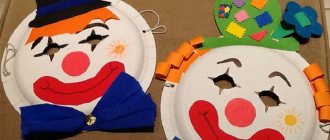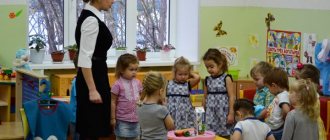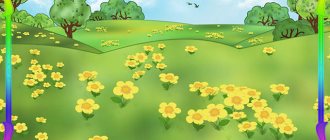Preview:
. Summary of educational activities for modeling for children of primary preschool age “Kitten”
The purpose of the GCD: to teach children to sculpt a four-legged animal - a cat.
Tasks: to consolidate sculpting techniques: rolling plasticine between the palms; consolidate the ability to connect parts, pressing them tightly against each other. Develop independence. Cultivate accuracy when working with plasticine.
Preliminary work: conversations with children about pets, looking at illustrations, reading fiction and educational literature, riddles, didactic games: “Who lives where?”, “Where is whose cub?”, “Find out by description.”
Materials: plasticine on boards (for each child) and separately on plates, stacks, oilcloths, boards, a modeling support diagram with an image (a kitten, a magnetic board, a layout with multi-colored balls, a disk with background music for the practical part.
Let's say "Hello!" each other.
Hi all!" and “Good afternoon!”;
Q: Guys, look, guests have come to us. Let's say hello to them. D: Good morning!
Q: Guys, come to me, please. Look what we have on the table?
Q: What kind of pet do you think likes to play with balls?
Q: Look how many glomeruli there are, are they the same? What color and shape are they?
D: red, yellow, etc. multi-colored, round.
Q: Guys, there are balls, but there is no one to play with them. What can we do?
Q: Let's make kittens so they can play with them.
Q: And in order for your ears to listen to me carefully, and your eyes to see what I’m going to show, let’s play with you.
Wash your cheeks with your paw (act in accordance with the text)
Right eye left eye
Q: After being kittens, we turn into guys and sit down in our seats. We sit down straight, backs straight, eyes on me.
Q: And now I’ll show you how to make a kitten.
Here I have a large piece of plasticine. I tear off a smaller piece - this will be the head of our kitten. Now I tear off an even smaller piece from a larger piece - this will be the tail of our kitten. And from this remaining piece of plasticine I will sculpt the body of our kitten. I will roll this piece of plasticine into a sausage. Then I take the stack and make longitudinal cuts on both sides of this sausage. These will be our kitten's paws. Now we take a piece from which I will roll a ball - this will be the head of our kitten. The ball can be rolled between straight palms or between the palm and the table.
We flatten the plasticine on both sides of the ball with two fingers (thumb and index) and we will get ears. Let's take buckwheat grains and make eyes, take a very small piece of black plasticine, roll a small ball between our fingers - this will be the kitten's nose. Then we take pieces of wire and attach whiskers to our kitten on both sides. Now we press the head to the body. There is a small piece of plasticine left, from which we will roll out a small sausage - this will be the kitten’s tail. We attach it to the body. Look what a wonderful kitten I got.
Finger gymnastics: “Kittens”
(We fold our palms, press our fingers together)
Our cat has ten kittens,
(We shake our hands without separating them)
Now all the kittens are in pairs:
(Tap the corresponding fingers against each other from the big to the little finger) Calm music sounds. Children make their own pet.
Self-analysis NOD: throughout the entire NOD maintained the children's interest in the result. Each child was actively involved in activities throughout the entire NOD. The children tried to use plasticine carefully.
Source
"Gifts for a kitten." Summary of GCD for modeling in the second junior group
Anna Maksimova
"Gifts for a kitten."
Abstract of GCD on modeling in the second junior group “ Gifts for a kitten ” Summary of GCD in the educational field “Artistic creativity” (
modeling ) in
the second junior group .
Topic: " Gifts for a kitten ."
Goal: Learn to sculpt plasticine balls.
Objectives: To introduce domestic animals and their babies, to develop the skill of word formation of nouns denoting baby animals; to cultivate a love for pets and a desire to take care of them, a kind attitude towards animals; learn to use acquired skills.
Materials and equipment: soft toys (cat and kitten , U balls, modeling , plasticine.
Sculpting lesson “Lost kittens”
Lesson objectives:
- To consolidate children's ideas about pets and the features of their appearance.
- Develop an interest in new ways of drawing.
- Continue to introduce children to the properties of plasticine (soft, pliable, able to take any shape)
- Teach children to achieve expressive rendering of shape, color, image of small details of an object.
- Cultivate accuracy when working with plasticine. Make children want to do something nice and give gifts.
- Develop fine motor skills of the hands.
Materials for the lesson: silhouette of a kitten, plasticine of bright colors, napkin for hands, paper napkin, board for modeling, stack, painting “Cat with kittens” from the series “Pets” (author S.A. Veretennikova).
Progress of the lesson
Organizational part
Children enter the group and approach the play area. The teacher asks the children to guess the riddle:
This animal lives only at home. You are familiar with this beast. He has a mustache like knitting needles, He sings a purring song, Only the mouse is afraid of him... Did you guess it? These are kids. Cat.
Articulation gymnastics.
Teacher: Guys, let's train our tongues so that they are dexterous, like kittens.
1. Let's show how a cat laps milk. 2. Let's chew with our mouth closed. 3. Pussy is angry.
The teacher shows the children the picture “Cat with Kittens.”
Teacher: A cat is a pet, it is attached to its home, its owners, it loves warmth and comfort. If the cat is well-fed, healthy and in a good mood, it purrs affectionately, and if the cat is angry, it releases its claws - “scratchers”, which are hidden in soft paws. A cat is a very clean animal. Loves to wash his fluffy face and fur. Guys, who do you see next to the cat?
Children: Kittens.
Teacher: Correct. They are very mischievous, love to play and also sleep.
The cat comes in crying.
Cat: Hello guys! My name is Murka.
Children: Hello Murka!
Cat: I’m such an unhappy cat, I’m in trouble, my kids and kittens are missing. Please help me find them.
Teacher: What happened?
Cat: I left the kids at home, went for milk myself, but they were nowhere to be found.
Teacher: Shall we help Murka find her kittens?
Children: Let's help.
Teacher: Guys, let’s play now. They can hear us and attack us themselves.
Physical education
Pussy, pussy, scat, - They stroke their hands. It’s not sad on the path. - They shake their fingers. Our children will go, - They will walk, they will stumble, they will fall. - Squat down.
We played and relaxed. The kittens didn't hear us. Now let's take our seats, there is one interesting task waiting for you there.
Practical part
Teacher: Before we get to work, let's warm up our fingers
The teacher distributes balls.
Finger gymnastics. Cunning, little Kitten (ball squeezed between palms) Just got out of diapers, (palms open) Did a lot of things: (palms close) Ate a fish from a raccoon, (circular movements between palms) Started a fight with a hamster, (Squeeze the ball in your right hand) Only the dog was scared. (squeeze in left hand) Ill-mannered child (circular movements on the table with one hand) This little Kitten. (circular movements on the table with the other hand)
Teacher: So we have prepared our fingers for work. There are napkins on your tables. Look under them, what did you see there? Let's take a closer look. Who is this?
Children: Kittens.
Teacher: Correct. But they are missing something. Let's say what?
Children: Eyes, antennae, mouth and tail.
Teacher: Correct. What a great fellow you are. Now let's draw eyes, antennae, mouth and tail from plasticine. First we make the eyes. We pinch off two small pieces from the green plasticine, roll two balls - a pea, and stick on the eyes. Then we move on to the mustache. For the antennae we take black light plasticine. Roll 6 thin and medium-length sausages and attach antennae. 3 sausages on the right, 3 sausages on the left.
Let's move on to the mouth. To draw a mouth, take red plasticine. Roll out a small oval, flatten it and stick on the mouth.
Now all that remains is to finish the tail. For the tail we use plasticine of the same light as our kitten. Roll the sausage and attach it to the side. You guys are all so great, you helped the kittens become just like everyone else. Now they have eyes and antennae, a mouth, and a tail.
Final part.
Teacher: Guys, let’s now put all our drawings on the exhibition board and look carefully. What did we do in class today?
Children: We finished drawing the kittens’ eyes, mouth, antennae and tail.
Teacher: What are they for?
Children: Eyes to see, a mouth to eat, whiskers to feel, and the tail helps cats jump; with the tail they also show their emotions. (Joy, not contentment).
Teacher: Correct. What did we draw all this with?
Children: With plasticine.
Teacher: Did you like drawing with plasticine?
Children: Yes.
Teacher: Let's now call Murka and ask her. Are these her missing kittens? Murka! Come to us, look, aren’t these your mischievous, missing kittens?
Murka: Yes, mine. Thank you guys for your help. Goodbye, guys!
Teacher: That's all guys, our lesson is over. Well done everyone!
Author: Zainullina Gulchachak Denisovna, teacher, MBDOU kindergarten No. 19 “Milashkey”, Bugulminsky municipal district of the Republic of Tatarstan.
The article is published in the author's edition.






